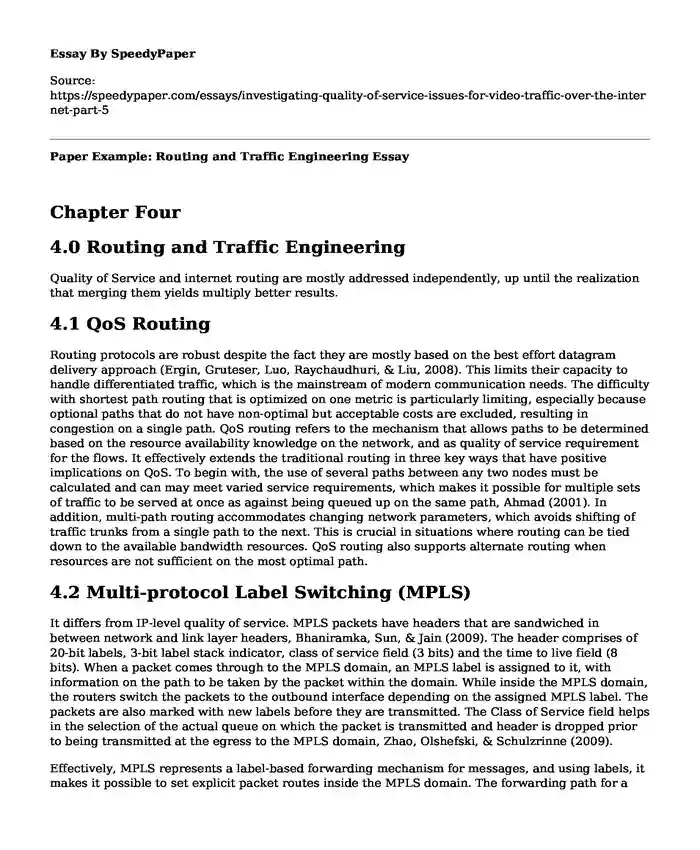
| Type of paper: | Essay |
| Categories: | Thesis Internet Information technologies Technology |
| Pages: | 3 |
| Wordcount: | 741 words |
Chapter Four
4.0 Routing and Traffic Engineering
Quality of Service and internet routing are mostly addressed independently, up until the realization that merging them yields multiply better results.
4.1 QoS Routing
Routing protocols are robust despite the fact they are mostly based on the best effort datagram delivery approach (Ergin, Gruteser, Luo, Raychaudhuri, & Liu, 2008). This limits their capacity to handle differentiated traffic, which is the mainstream of modern communication needs. The difficulty with shortest path routing that is optimized on one metric is particularly limiting, especially because optional paths that do not have non-optimal but acceptable costs are excluded, resulting in congestion on a single path. QoS routing refers to the mechanism that allows paths to be determined based on the resource availability knowledge on the network, and as quality of service requirement for the flows. It effectively extends the traditional routing in three key ways that have positive implications on QoS. To begin with, the use of several paths between any two nodes must be calculated and can may meet varied service requirements, which makes it possible for multiple sets of traffic to be served at once as against being queued up on the same path, Ahmad (2001). In addition, multi-path routing accommodates changing network parameters, which avoids shifting of traffic trunks from a single path to the next. This is crucial in situations where routing can be tied down to the available bandwidth resources. QoS routing also supports alternate routing when resources are not sufficient on the most optimal path.
4.2 Multi-protocol Label Switching (MPLS)
It differs from IP-level quality of service. MPLS packets have headers that are sandwiched in between network and link layer headers, Bhaniramka, Sun, & Jain (2009). The header comprises of 20-bit labels, 3-bit label stack indicator, class of service field (3 bits) and the time to live field (8 bits). When a packet comes through to the MPLS domain, an MPLS label is assigned to it, with information on the path to be taken by the packet within the domain. While inside the MPLS domain, the routers switch the packets to the outbound interface depending on the assigned MPLS label. The packets are also marked with new labels before they are transmitted. The Class of Service field helps in the selection of the actual queue on which the packet is transmitted and header is dropped prior to being transmitted at the egress to the MPLS domain, Zhao, Olshefski, & Schulzrinne (2009).
Effectively, MPLS represents a label-based forwarding mechanism for messages, and using labels, it makes it possible to set explicit packet routes inside the MPLS domain. The forwarding path for a packet is entirely determined by the assigned label and in the event that a packet crosses all the domains, then end-to-end path will be found for the packet, Cho & Okamura (2010). Labels also serve to classify the packets more easily and efficiently than the usual scheduling and queuing protocols. It can also help in the routing multiple network layer protocols inside a network, besides being used for efficient tunneling mechanisms that facilitate traffic engineering. For instance, switching of tables must be sent to MPLS routers from the main controller that is identical to a policy server. The effective configuration of the tables may be intricate, which in turn results in massive difficulties with scalability, Chiu, Huang, Lo, Hwang, & Shieh (2003).
MPLS major performance factor that is associated with traffic engineering is classified as resource or traffic oriented depending on whether the intention is to expedite traffic or bolster the efficiency of resource-utilization, Bhaniramka, Sun, & Jain (2009). MPLS represents a strategically crucial, traffic engineering technique, especially because of its potential to offer the best of the functionality that is available from an overlay model in a manner that is integrated, without significant cost implications. In addition, MPLS provides possible opportunities for traffic engineering automation.
4.3 Label Distribution Protocols (LDP)
It is implemented in the form of messages and procedures, according to which LSRs can establish LSPs over a network through mapping network layer routing of information directly to the data-link layer paths. The LDP relates sets of FEC with every LSP that it creates, and the FEC that is associated with the LSP lays out which packets have been mapped onto the LSP. The LSps may be extended through the network, because each LSR splices the incoming labels for FEC to the outbound label, which is assigned to the subsequent hop for every FEC, Martinez, Apostolopoulos, Alfaro, Sanchez, & Duato (2010).
Cite this page
Paper Example: Routing and Traffic Engineering. (2017, Aug 03). Retrieved from https://speedypaper.com/essays/investigating-quality-of-service-issues-for-video-traffic-over-the-internet-part-5
Request Removal
If you are the original author of this essay and no longer wish to have it published on the SpeedyPaper website, please click below to request its removal:
- Giving Birth Control to Teenagers - Essay Example
- Free Essay on the Article: Exploratory Analysis of the Shopping Orientation in the Tunisian Context
- Essay Sample Analyzing Babylon Revisited by F. Scott Fitzgerald
- Psychology Essay Sample: The Environmental Effects of Crime in the African American community
- Essay Example Dedicated to Monetary Policy Tools
- Superstitious Beliefs and Happiness: A Correlation Study of Young Adults
- Essay Sample on Failed Collaboration and Organizational Behavior
Popular categories




